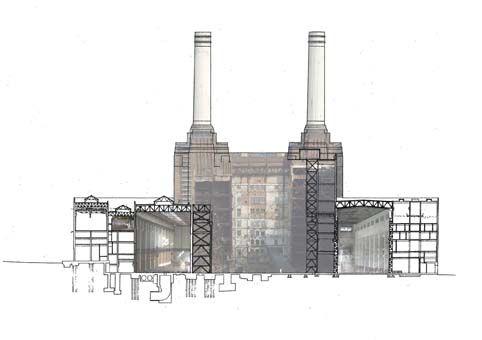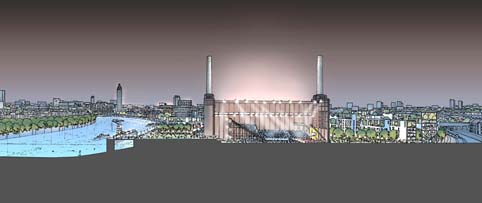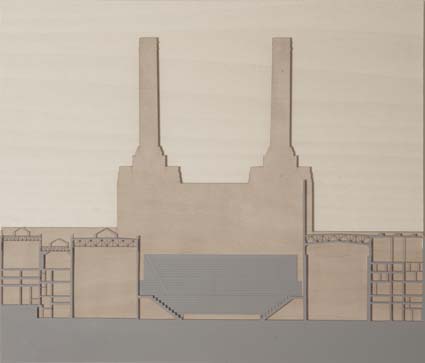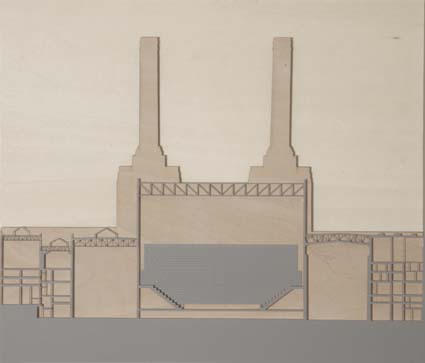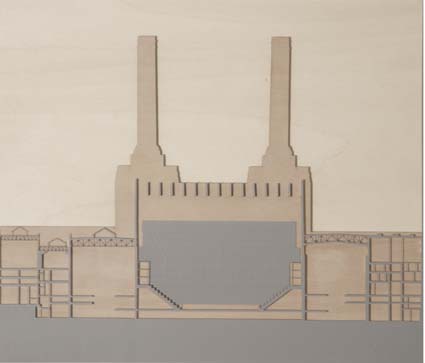SAVE teams up with Allies & Morrison on new Battersea Scheme
18.4.12
SAVE has teamed up with Allies and Morrison Architects to devise a step by step proposal to re-use and save Battersea Power Station. Unlike some recent proposals this route to development retains the whole magnificent building. The key to its re-use lies in a gradual approach - inhabiting the great former Boiler House between the four chimneys at first in a raw state for temporary events, and progressively attracting further uses and converting the building as the venu starts to establish a new focal point on the south bank.
Step 1 is to use it in a raw state with the minimum necessary structural support and repair, as an open air venu for concerts. There will be a covered stage and temporary raked seating. Step 2 introduces a lightweight roof, a permanent raised floor with facilities below, permanent stage, side stages and raked seating. Step 3 introduces hospitality boxes for sponsors.
The main arena will be substantially larger than the Albert Hall and will be comparable to the 1930s Wembley arena and thus suitable for pop concerts and events such as national television, film and music industry awards. It will seat up to 11,000 spectators.
We also believe that Battersea Power Station is a location and an address which will appeal to a wide range of creative and enterprising people and organisations as a place to work. The two Turbine Halls therefore function as open atriums which can be used for events, receptions, exhibitions and launches in much the same way as the Royal Agricultural Hall with offices and studios in the space around.
The former coal bunker area on the river front will be preserved as an open space for recreation and events. Surrounding new buildings will be kept lower than in recent schemes, providing a better contrast to the awesome size of the power station as well as a more human scale. The Grade 2 listed Water Pumping Station will also be retained.
New buildings on the 40 acre site, which is already largely cleared for development, will be laid out framing the main vistas of the power station, and organised so they can be built in small self-contained phases, if appropriate by different developers to an agreed masterplan. There will be a linear park through the development connecting with that planned all the way to Vauxhall.
SAVE's President Marcus Binney says 'SAVE led the campaign to save Battersea Power Station and obtained the first planning permission for conversion to leisure use. The Power Station is one of London's most imposing landmarks, its distinctive column chimneys visible from many viewpoints across the city. Its wonderful riverside position, and its capacity to hold large audiences, provide the potential for a very popular venu, providing both an indoor and outdoor alternative to concerts in places such as Hyde Park. The Power Station has the added attraction of immensely grand entrance fronts on both the river and land sides. The column chimneys soaring to 103 metres (338feet) making an unforgettable impression on every who arrives there.'
IN 1981 with architects Martin Richardson and Graham Morrison SAVE published The Colossus of Battersea, showing how the Power Station could be adapted for sports use with a 160m lap length athletics track and seating for 9000-11000 spectators set in the Boiler House within the four chimneys, together with sports and other facilities in the flanking buildings.
SAVE was granted planning permission for sports and leisure use of the power station in 1982 – a permission which has served as the basis for all later proposals and permissions for the power station.
Later proposals for conversion have relied on extensive alteration of the building and have also been hindered by heavy transport infrastructure costs all of which placed financial strain on development. Subsequent owners have found it difficult to find a viable use for the great, now un-roofed, space between the four chimneys measuring 145x62m. Returning to Allies & Morrison, we now propose a step by step approach to the reuse of the great boiler house.
Whether or not the proposed extension to the Northern Line at Kennington is built, we believe the Power Station can be provided with rapid shuttle bus connections to Sloane Square, Victoria Station, Vauxhall Station, Clapham Junction (all major transport nodes) as well as to nearby overland trains at Battersea Park. There will also be a riverwalk from Chelsea Bridge under the railway bridge to the riverside forecourt.
The Allies & Morrison proposals illustrated here will give Battersea Power Station a new life as one of London’s most thrilling landmarks with regular public access and numerous major events.
Although the former Boilerhouse between the four chimneys has been unroofed other fine interiors of Battersea Power Station survive largely unaltered. The 1930s faience clad Turbine Turbine Hall A remains, overlooked by the remarkable control room room which retains all its jazz age lighting and switching equipment complete with the names of streets and neighbourhoods to which electrity was delivered. Turbine Hall B also survives with all the equipment in the control room.
SAVE has consulted leading events organisers about the suitability of BPS an an events venu. An enthusiastic response has come from Indigo Television 'Indigo Television organises large scale entertainment events such as the UK’s No.1 awards event The National Television Awards on behalf of major broadcasters. Venues hired by Indigo in the capital for recent events include The O2, Wembley Arena, The Royal Albert Hall and London Festival Hall.
When selecting a venue with the broadcaster there are key practical requirements of location, access, capacity - especially the potential for large capacity audiences, flexibility of use, amenities and facilities etc, but there is also the all-important consideration of the visual impression that the venue will project to the audience attending and watching the broadcast. We believe that event producers such as Indigo would welcome the powerful and iconic setting that BPS could provide as a new London venue in the heart of the Capital.'
Notes
Allies and Morrison is an architecture and urban planning practice based in London. It operates from its own studios in Southwark Street, the RIBA London Building of the Year 2004.
The practice has completed projects throughout the UK and is currently undertaking work in Germany, Netherlands, India, Malawi, Beirut, Abu Dhabi and Qatar. In 2009 it opened an office in Doha.
Allies and Morrison brings to all its projects the same rigorous approach which places importance on the way buildings work, the way they are made, and the public spaces
they generate.
The practice was named Architect of the Year in the 2007 Building Design Awards and has won 30 RIBA Awards across a diverse range of projects including: BBC Media Village, British Embassy Dublin, Girton College Library and Archive, Bankside 123, Highbury Square, Paradise St - Liverpool One, Abbey Mills Pumping Station, Charles St Car park and the Royal Festival Hall.


